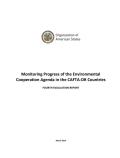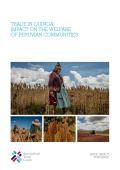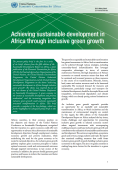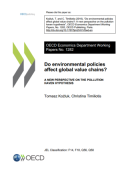
Since 2005, the United States has invested approximately US$ 87.2 million to fund the Central America-Dominican Republic-United States Free Trade Agreement (CAFTA-DR) environmental cooperation. This funding is helping CAFTA-DR countries advance in the following four programmatic areas: (A) Institutional Strengthening for Effective Implementation and Enforcement of Environmental Laws; (B) Biodiversity and Conservation; (C) Market-based Conservation; and (D) Improved Private Sector Performance.
In support of these areas, the Environmental Cooperation Agreement (ECA) (Article IV) requires that the Environmental Cooperation Commission (ECC) be responsible for examining and evaluating the cooperation activities under the Agreement. The ECA highlights as well that the ECC must also seek and consider input from relevant international organizations and other stakeholders regarding how best to ensure that it is accurately monitoring progress.


This policy brief is the last in a series of six briefs, drawn from Achieving Sustainable Development in Africa through Inclusive Green Growth, a joint publication of the Economic Commission for Africa (UNECA), the Food and Agriculture Organization of the United Nations, the United Nations Industrial Development Organization and the United Nations Development Programme on the theme of "achieving sustainable development in Africa through inclusive green growth". Specifically, this policy brief looks at the potential to leverage trade in achieving green growth as trade plays an important role in the world economy and can spur economic gorwth on teh African continent. It recognised that while extractives, particularly fossil fuels, raw ores and metals, dominate Africa’s exports to the rest of the world, African countries can achieve inclusive green growth within a highly globalized and competitiven world market by harnessing their abundant natural resources, which also provide a broad range of benefits across the various sectors of society.

This is the first in a series of six briefs, drawn from Achieving Sustainable Development in Africa through Inclusive Green Growth, a joint publication of the Economic Commission for Africa (UNECA), the Food and Agriculture Organization of the United Nations, the United Nations Industrial Development Organization and the United Nations Development Programme on the theme of "achieving sustainable development in Africa through inclusive green growth". This brief provides a snapshot of the key findings, which are further highlighted in subsequent policy briefs in this series.
This policy brief provides an overlook of green growth in a number of sectors, including agriculture, ecosystem goods and services, energy, industry, and trade. It also examines various enablers for the transition toward a green economy.

Increasing international fragmentation of production has reinforced fears that industrial activity may flee to countries with laxer environmental policies – in line with the so-called Pollution Haven Hypothesis (PHH). If PHH effects are strong, domestic responses to environmental challenges may prove ineffective or meet strong resistance. Using a gravity model of bilateral trade in manufacturing industries for selected OECD and BRIICS countries over 1990s-2000s, this paper studies how exports are related to national environmental policies. Environmental policies are not found to be a major driver of international trade patterns, but have some significant effects on specialisation. More stringent domestic policies have no significant effect on overall trade in manufactured goods, but are linked to a comparative disadvantage in "dirty" industries, and a corresponding advantage in "cleaner" industries. The effects are stronger for the domestic component of exports than for gross exports, yet notably smaller than the effects of e.g. trade liberalisation.
